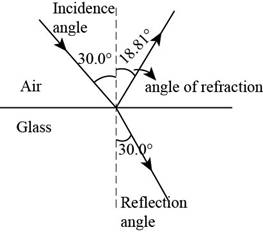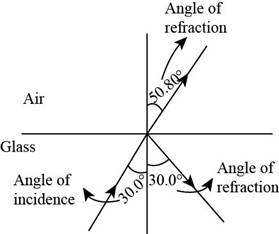
Concept explainers
(a)
The angle of the reflected and refracted rays when light ray incident from the air at angle of incidence
(a)
Answer to Problem 52AP
The angle of reflection is
Explanation of Solution
Given info: The index of refraction of glass is
From, law of reflection, the angle of incidence is equal to the angle of reflection.
Thus, angle of reflection is
From Snell’s law,
Here,
Substitute
The figure below shows the angle of incidence, the angle of reflection and the angle of refraction.

Figure (1)
Conclusion:
Therefore, the angle of reflection is
(b)
The angle of the reflected and refracted rays when light ray incident from the glass at angle of incidence
(b)
Answer to Problem 52AP
The angle of reflection is
Explanation of Solution
Given info: The index of refraction of glass is
From, law of reflection, angle of incidence is equal to angle of reflection.
Thus, angle of reflection is
From, Snell’s law,
Here,
Substitute
The figure below shows the angle of incidence, the angle of reflection and the angle of refraction.

Figure (2)
Conclusion:
Therefore, the angle of reflection is
(c)
The angles of reflection and refraction for all angles of incidence at
(c)
Answer to Problem 52AP
The angle of reflection is same as the angle of incidence and the angle of refraction for rays incident from air onto the air-glass surface is increasing as angle of incidence is increasing. The table for different values of angles is,
| Angle of incidence | Angle of reflection | Angle of refraction |
|
|
|
|
|
|
|
|
|
|
|
|
|
|
|
|
|
|
|
|
|
|
|
|
|
|
|
|
|
|
|
|
|
|
|
|
|
|
|
|
Explanation of Solution
From, law of reflection, the angle of reflection is equal to the angle of incidence. So for all value of angles between
The formula to calculate the angle of refraction is,
From, Snell’s law,
Substitute
Substitute
The remaining values of the angle of refraction can be calculated by the same method.
The table for angle of reflection and angle of refraction for all angles of incidence at
| Angle of incidence | Angle of reflection | Angle of refraction |
|
|
|
|
|
|
|
|
|
|
|
|
|
|
|
|
|
|
|
|
|
|
|
|
|
|
|
|
|
|
|
|
|
|
|
|
|
|
|
|
Conclusion:
Therefore, the angle of reflection is same as the angle of incidence and the of angle of refraction for rays incident from air onto the air-glass surface is increasing as angle of incidence is increasing.
The table for angle of reflection and angle of refraction for all angles of incidence at
| Angle of incidence | Angle of reflection | Angle of refraction |
|
|
|
|
|
|
|
|
|
|
|
|
|
|
|
|
|
|
|
|
|
|
|
|
|
|
|
|
|
|
|
|
|
|
|
|
|
|
|
|
(d)
The angles of reflection and refraction for all angles of incidence at
(d)
Answer to Problem 52AP
The angle of reflection is same as the angle of incidence and the of angle of refraction for rays coming up to the interface through the glass will increase up to angle of incidence
The table for angle of reflection and angle of refraction for all angles of incidence at
|
Angle of incidence(
(
|
Angle of reflection(
|
Angle of refraction(
|
|
|
|
|
|
|
|
|
|
|
|
|
|
|
|
|
|
|
|
|
|
|
|
|
|
|
|
|
|
|
|
|
|
|
|
|
|
|
|
|
Explanation of Solution
From, the law of reflection, angle of reflection is equal to the angle of incidence. So, for all value of angles between
The formula to calculate the angle of refraction is,
From, Snell’s law,
Substitute
Substitute
The remaining values of the angle of refraction can be calculated by the same method.
The formula to calculate the critical angle is,
Here,
Substitute
The angle of incidence is greater than
The table for angle of reflection and angle of refraction for all angles of incidence at
|
Angle of incidence(
(
|
Angle of reflection(
|
Angle of refraction(
|
|
|
|
|
|
|
|
|
|
|
|
|
|
|
|
|
|
|
|
|
|
|
|
|
|
|
|
|
|
|
|
|
|
|
|
|
|
|
|
|
Conclusion:
Therefore, the angle of reflection is same as the angle of incidence and the of angle of refraction for rays coming up to the interface through the glass will increase up to angle of incidence
The table for angle of reflection and angle of refraction for all angles of incidence at
|
Angle of incidence(
(
|
Angle of reflection(
|
Angle of refraction(
|
|
|
|
|
|
|
|
|
|
|
|
|
|
|
|
|
|
|
|
|
|
|
|
|
|
|
|
|
|
|
|
|
|
|
|
|
|
|
|
|
Want to see more full solutions like this?
Chapter 35 Solutions
Bundle: Physics for Scientists and Engineers with Modern Physics, Loose-leaf Version, 9th + WebAssign Printed Access Card, Multi-Term
- 7. Are all scientific theories testable in the commonly understood sense? How does this make you feel? How should you proceed as a scientist or engineer with this understanding?arrow_forwardWhat is an an example of a hypothesis that sounds scientific but is notarrow_forwardWhat is an example of a scientific hypothesisarrow_forward
- Multiverse is called a theory. It has been proposed to account for the apparent and uncanny fine tuning of our own universe. The idea of the multiverse is that there are infinite, distinct universes out there - all with distinct laws of nature and natural constants - and we live in just one of them. Using the accepted definition of the universe being all that there is (matter, space and energy), would you say that multiverse is a scientific theory?arrow_forwardHow is a law usually different than a theoryarrow_forwardA 1.50 mLmL syringe has an inner diameter of 5.00 mmmm, a needle inner diameter of 0.270 mmmm, and a plunger pad diameter (where you place your finger) of 1.2 cmcm. A nurse uses the syringe to inject medicine into a patient whose blood pressure is 140/100. Part A What is the minimum force the nurse needs to apply to the syringe? Express your answer with the appropriate units. View Available Hint(s)for Part A Hint 1for Part A. How to approach the question The force the nurse applies to the syringe can be determined from the fluid pressure and the area of the plunger. The minimum force corresponds to the patient's lowest blood pressure. Use the following equality 760mmofHg=1atm=1.013×10^5Pa760mmofHg=1atm=1.013×10^5Pa.arrow_forward
- A 1.50 mLmL syringe has an inner diameter of 5.00 mmmm, a needle inner diameter of 0.270 mmmm, and a plunger pad diameter (where you place your finger) of 1.2 cmcm. A nurse uses the syringe to inject medicine into a patient whose blood pressure is 140/100. Part A What is the minimum force the nurse needs to apply to the syringe? Express your answer with the appropriate units. View Available Hint(s)for Part A Hint 1for Part A. How to approach the question The force the nurse applies to the syringe can be determined from the fluid pressure and the area of the plunger. The minimum force corresponds to the patient's lowest blood pressure. Use the following equality 760mmofHg=1atm=1.013×10^5Pa760mmofHg=1atm=1.013×10^5Pa.arrow_forwardIs a scientific theory supposed to just be someone's idea about somethingarrow_forwardwhat is the agenda of physicsarrow_forward
 Principles of Physics: A Calculus-Based TextPhysicsISBN:9781133104261Author:Raymond A. Serway, John W. JewettPublisher:Cengage Learning
Principles of Physics: A Calculus-Based TextPhysicsISBN:9781133104261Author:Raymond A. Serway, John W. JewettPublisher:Cengage Learning Physics for Scientists and Engineers: Foundations...PhysicsISBN:9781133939146Author:Katz, Debora M.Publisher:Cengage Learning
Physics for Scientists and Engineers: Foundations...PhysicsISBN:9781133939146Author:Katz, Debora M.Publisher:Cengage Learning An Introduction to Physical SciencePhysicsISBN:9781305079137Author:James Shipman, Jerry D. Wilson, Charles A. Higgins, Omar TorresPublisher:Cengage Learning
An Introduction to Physical SciencePhysicsISBN:9781305079137Author:James Shipman, Jerry D. Wilson, Charles A. Higgins, Omar TorresPublisher:Cengage Learning Physics for Scientists and EngineersPhysicsISBN:9781337553278Author:Raymond A. Serway, John W. JewettPublisher:Cengage Learning
Physics for Scientists and EngineersPhysicsISBN:9781337553278Author:Raymond A. Serway, John W. JewettPublisher:Cengage Learning Physics for Scientists and Engineers with Modern ...PhysicsISBN:9781337553292Author:Raymond A. Serway, John W. JewettPublisher:Cengage Learning
Physics for Scientists and Engineers with Modern ...PhysicsISBN:9781337553292Author:Raymond A. Serway, John W. JewettPublisher:Cengage Learning University Physics Volume 3PhysicsISBN:9781938168185Author:William Moebs, Jeff SannyPublisher:OpenStax
University Physics Volume 3PhysicsISBN:9781938168185Author:William Moebs, Jeff SannyPublisher:OpenStax





